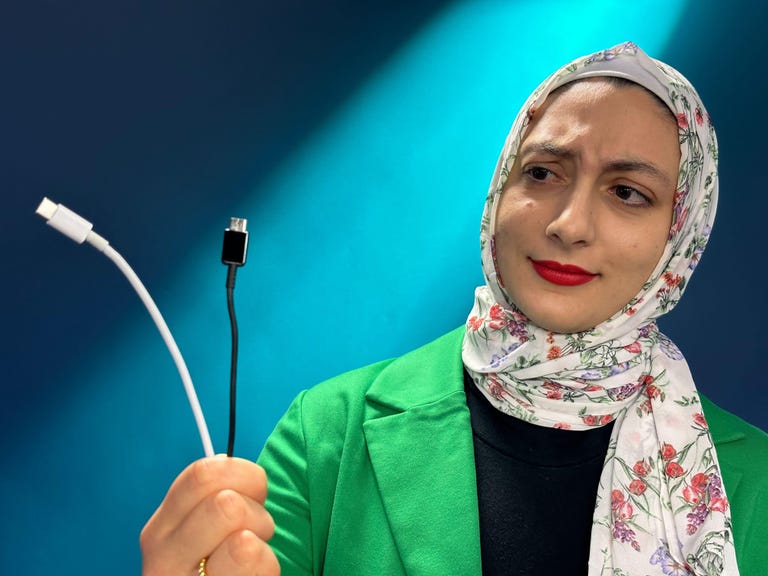I love USB-C, the data and charging port I first encountered in my 2016 MacBook Pro that has since spread to almost every device in my life and now is arriving on the new iPhone 15 smartphones and AirPods Pro 2 earbuds.
I wanted a USB-C iPhone in 2018, back when Apple first added that tech to the iPad Pro. I grew more optimistic in 2021, when Apple spread USB-C to lower-end iPads. And though I’m skeptical that regulation is the best way to direct product development, I’m not displeased that the European Union has now pushed Apple toward USB-C. Charging everything with USB-C is great for me.
So I’m psyched the iPhone 15 models all get USB-C ports. But here’s the bad news Apple didn’t share at its iPhone launch event last Tuesday: Millions of people entering the USB-C ecosystem will encounter the technology’s ugly side too.
The utility and flexibility of USB-C are tainted by confusion over just what the heck comes along with that USB-C port on the side of a device and the cable you plug into it. In short, it’s not always obvious whether your device or cable supports high-speed data transfer, high electrical power for fast charging, both or neither.


One of the great things about USB-C is how broad the product ecosystem is. Want a sturdy cable that’s compact enough to fit on your keychain? Nomad sells one — though it only supports slow USB 2.0 data transfer rates.
Having three standards — USB, USB-C and USB PD — makes it harder to understand the abilities of all your devices and cables.
Worse, plenty of device manufacturers trying to cut costs and quickly ship products skip the certification process that the USB Implementers Forum offers. Unlike with Intel’s Thunderbolt, which developed the fast data transfer approach in modern USB, there’s no requirement to pass tests.
Low costs fuel USB-C’s problems
Nobody wants to spend $60 instead of $15 for a USB cable. But be careful: You get what you pay for, roughly. It’s more expensive to build cables that support high-speed data or high-power charging. One rule of thumb: Cables billed as “charging cables” in my experience don’t bother with the extra cost of high-speed data support. That includes the USB-C cables Apple itself shipped with MacBooks for several years.
One affordable cable I saw billed itself as a USB 4 product, but on deeper inspection, it turned out to support only USB 2.0 data transfer. Either the manufacturer was confused, lying or trying to argue that the cable would work in a USB 4 port even if it only supported slow data rates. (USB’s good backward compatibility means slower, older products generally still work fine when attached to newer ones.)
More from the Apple event
I haven’t struggled too much with the slow cable problem. Mostly, I use USB-C for charging, and my devices that need fast connections stay attached to their own fast cables.
But problems can happen. A couple of months ago, when I got a new Canon mirrorless camera, I was caught on a trip with slow cables that really bogged down the process of transferring photos to my laptop.
When USB-C is a problem and when it’s not
The good news for future iPhone owners is that most of them won’t have to care much about whether they have a slow cable. Indeed, iPhone 15 non-Pro phone owners won’t be able to benefit from the speeds of a fast cable even if they have one.
Data rates were more important in the olden days when we used iTunes to sync music and photos between laptops and iPhones. Even as photo and video files have exploded in size with 50-megapixel phone cameras and 4K video, most of us get that data off our phones with mobile networks, Wi-Fi and AirDrop, not with cables.
That’s the big reason Apple could mostly justify shipping an iPhone 15 with a USB 2.0 cable.
Now, for serious data hogs, the kind of person who’s shooting many gigabytes of 4K ProRes video, a faster cable is useful. It’s one reason I’ve been annoyed with the Lightning port on my iPhone. Those customers will, I hope, generally be discriminating enough to find a high-quality cable for their needs — or, if rumors are correct, just use the faster cable that Apple will ship with iPhone 15 Pro models. (Apple hasn’t yet revealed what’s ships with the new phones.)
I prefer buying USB-C products that have passed USB-IF’s compliance testing. I look for the USB-IF certifications, and I love it when companies like Plugable attach clear descriptive labels so we don’t have to decode USB-IF icons. (And most products don’t even have icons.)

